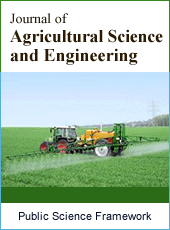Journal of Agricultural Science and Engineering
Articles Information
Journal of Agricultural Science and Engineering, Vol.1, No.3, Aug. 2015, Pub. Date: Jun. 24, 2015
The Effects of Deficit Irrigation Regimes on Yield and Growth Components of Linseed (Linum Usitatissimum L.)
Pages: 108-113 Views: 5344 Downloads: 1442
[01]
Ahmet Istanbulluoglu, Namik Kemal University, Agricultural Faculty, Biosystem Engineering Department, Tekirdağ, Turkey.
[02]
Fatih Konukcu, Namik Kemal University, Agricultural Faculty, Biosystem Engineering Department, Tekirdağ, Turkey.
[03]
Israfil Kocaman, Namik Kemal University, Agricultural Faculty, Biosystem Engineering Department, Tekirdağ, Turkey.
[04]
Mehmet Sener, Namik Kemal University, Agricultural Faculty, Biosystem Engineering Department, Tekirdağ, Turkey.
A field study was carried out in order to determine the effect of deficit irrigation regime on grain and oil yield, seasonal evapotranspiration, yield response to water, water use efficiency and linseed (Linum usitatissimum L.) growth in Trakya region, Turkey. The field trials were conducted on a clay loam Entisol soil with Raulin, regionally most popular variety. The trials experimental design was randomized complete blocks with three replications. Three well-known growth stages of the plant were considered and total of 8 irrigation treatments (including rain). The effect of irrigation and water stress at any stage of development was studied on the following variables: grain yield per hectare, tgrain weight, oil yield and plant growth. For the non-stressed treatment, the seasonal irrigation water use and evapotranspiration were 270 and 730 mm, respectively, and linseed grain yield was 2.85 t/ha. The seasonal yield response factor value was 1.32. The total water use efficiency was in the range 3.0 to 4.1 kg/ha/mm depending on the deficit irrigation regime. Results showed that linseed was significantly affected by water stress during the sensitive flowering stage (include statistic results), with the highest yield obtained from non-stressed treatment during the flowering, yield formation and ripening stages.
Evapotranspiration, Deficit Irrigation, Linseed, Grain Yield, Yield Response to Water, Plant Growth Components
[01]
Anonymous, 2010. Land Resources of Tekirdag Province. General Directorate of Rural Affairs, Provincal Report. No: 59, 78 p., Ankara-Turkey.
[02]
Anonymous, 2015, Mean and extreme temperature and precipitation. General Directorate of State Meteorological Affairs. No:42, 678 p., Ankara-Turkey.
[03]
Doorenbos, J and A.H. Kassam, 2008. Yield response to water. Irrigation and Drainag, pp 33. FAO, United Nations, Rome.
[04]
Fereres, E. and M.A. Soriano, 2007. Deficit irrigation for reducing agricultural water use. Journal of Experimental Botany. 58(2): 147-159.
[05]
Geerts, S. and D. Raes, 2009. Deficit irrigation as an on-farm strategy to maximize crop water productivity in dry areas. Agricultural Water Management. 96: 1275-1284.
[06]
Gencer, O., 1993. General Field Crops (Industrial Crops). Cukurova University Agricultural faculty Publication. Adana.
[07]
Kirda, C., 2002. Deficit irrigation scheduling based on plant growth stages showing water stress tolerance. Deficit irrigation practices. FAO Corporate Document Repository 22. Rome. pp.3-10.
[08]
Kurt, O., H. Doğan and A. Demir, 2006. An investigation to establish suitable winter linseed cultivars for Samsun ecological condition. Journal of Ondokuz Mayıs University Agricultural Faculty, 21(1):1-5.
[09]
OCP, 2007. Pioneer Farmer Project. Agricultural Information and Marketing Association, Tekirdağ-Türkiye.
[10]
Pereira, L.S., T. Oweis and A. Zairi, 2002. Irrigation management under water scarcity. Agricultural Water Management. 57: 175-206.
[11]
Schuster, W.H., 1992. Lein/Flachs (Linum usitatissimum L.), in: Olpflanzen ibn Europa. DLG-Verlag, Frankfurt am Main, 239 p.
[12]
Stewart, J.I., R.H. Cuenca, W.O. Pruit, R.M. Hagan and J. Tosso, 1977. Determination and utilization of water production functions for principal California crops. W-67 California Contribution Project Report. Davis, United States of America, Universiyt of California.
[13]
Tuncturk, M., 2007. Investigation of some linseed cultivars (Linum usitatissimum L.) yield and yield components under Van conditions. Ankara University Agricultural Faculty Agricultural Science Journal, 13(4), 365-371.
[14]
Ugur, O.D. and N. Arslan, 1997. Effect of seed and nitrogen fertilizer amounts on linseed yield and yield components. Journal of Turkish Agriculture, 1(1), 6-12.
[15]
Unger, P.W., D.W. Fryrear and M.J. Lindstrom, 2006. Soil Conservation. American Society of Agronomy Monograph Series No: 23. Madison, WI: American Society of Agronomy. pp. 87-112.
[16]
Yurtsever, N., 1984. Mothods for Experimental Statics. Ministry of Agriculture, Forestry and Rural Affairs Press. 625 p.

ISSN Print: 2381-6821
ISSN Online: 2381-6848
Current Issue:
Vol. 7, Issue 4, December Submit a Manuscript Join Editorial Board Join Reviewer Team
ISSN Online: 2381-6848
Current Issue:
Vol. 7, Issue 4, December Submit a Manuscript Join Editorial Board Join Reviewer Team
| About This Journal |
| All Issues |
| Open Access |
| Indexing |
| Payment Information |
| Author Guidelines |
| Review Process |
| Publication Ethics |
| Editorial Board |
| Peer Reviewers |


